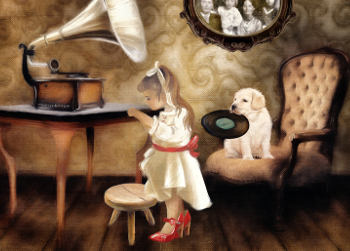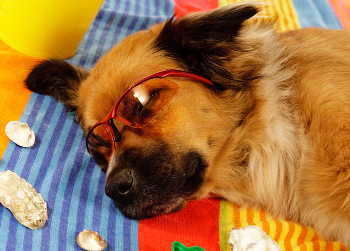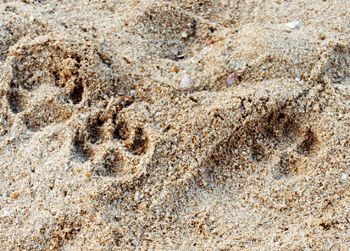Disease #6

Calicivirus is one of the most common causes of respiratory disease in cats; particularly in young kittens. The virus itself, has numerous serological types and these differ in the severity of disease presented in the cat.
Calicivirus is extremely infectious to other cats. It is most common where cats are found the most in close quarters. This includes boarding facilities and animal shelters. The virus incubates in the cat for about 3 or so days. The infection lasts for about 3 weeks but during that entire time, the cat can transmit the disease to other cats. Other cats that cause problems are carriers. These are clinically normal cats that carry the virus and can easily infect other susceptible cats. Pregnant queens can transmit the disease in utero to her unborn kittens. This is a nasty feline virus and easily prevented. It is a member of the core feline vaccination program.
Clinical signs of calicivirus vary depending upon the serological strain that the animal is infected with. Most clinical signs are respiratory. A bilateral muco-purulent nasal discharge is present forcing the cat to sneeze a lot. A hallmark of calicivirus are the oral ulcers that are found throughout the oral cavity. Many cats also will have bilateral conjunctivitis which is also painful. Cats are also lethargic and have very little appetite. Cats have to smell their food prior to eating it and the olfactory device ie: the nose can not perform that job well when sick.
All viruses cause a drop in white cells so a CBC is performed to evaluate the cellular immune response ie: by looking at the neutrophil and lymhocyte counts. In certain cases veterinarians can have the virus diagnosed via a PCR lab test.
Diagnosis is usually made by the oral ulcers present in the mouth cavity plus the majority of patients are usually 6 months of age or younger. It can also be diagnosed by a PCR lab test.
There are no antibiotics that effectively treat any virus. Viruses lower the immune response making the animal susceptible to a secondary bacterial infection. This is why most veterinarians will put the animal on an antibiotic such as Clavamox® drops for 10 days. An opthalmic ointment is also dispensed to take care of cats that have conjunctivitis. Supportive care such as nebulization/steam vapor will make the cat feel more comfortable. It is important that animals start to eat as soon as possible and I highly recommend Hills® Prescription a/d for this purpose.
With appropriate medical care the prognosis for calicivirus patients is excellent. The only problem is that they are highly contagious for 3 weeks to other susceptible animals. The best bet is prevention. This means starting kitten vaccination at 6-8 weeks, followed by a booster in 4-5 weeks than once annually.



The cause of canine hip dysplasia is a faulty development (in congenital cases) of the hip joint and in middle aged to older dogs, a breakdown in joint cartilage leading bone to grind against bone causing intense hip pain and arthritis. It is a genetic disease in German Shepherd dogs but is most commonly seen in large breeds of dogs such as: Rottweiller, Great Dane, Golden Retrievers and Labrador Retrievers.
In congenital Canine Hip Dysplasia the angles of the femur and pelvis are not normal and this causes abnormal wear and tear on the hip joint ie: the femoral head and acetabulum. This leads to clinical signs. In middle aged dogs and up, bone cartilage degrades allowing bone to grind against bone causing inflammation and the resultant lameness and discomfort.
The most common clinical signs are limping on the affected limb, reluctant to exercise and a reluctance to go upstairs. Animals may cry out when touched or pet on the hind quarters. This is known as referred pain. If left untreated, dogs are immobilized and are unable to get up to urinate or defecate or even get to the food bowl. These are called downer dogs and are usually seen in advanced cases.
The most effective lab tool is radiographing the hips. This entails two different views at perpendicular angles. The degree and or severity of the dysplasia is easily figured out. If an animal is older, a CBC and Chemistry profile are in order. Clinical signs of hip dysplasia can mimic other disease processes such as fractures, osteosarcomas and muscular dysplasia in the quadriceps. For breeding purpose the Orthopedic Foundation for Animals (OFA) offers a diagnostic test to ascertain if animals should be bred. Dogs that test positive should not be bred as the gene will be passed down to its progeny.
Diagnosis in lame animals is made via a good history and physical exam. Radiographs will confirm a diagnosis. In healthy animals, radiographs interpreted by the OFA will diagnose the condition. The dogs need to be at least two years of age for OFA certification.
Treatment of Canine Hip Dysplasia is usually directed to correcting as many of the arthritis problems present as well as controlling pain. In advanced cases, animals may undergo a complete hip replacement at specialty practices. The majority are treated medically. Joint inflammation is taken care of by special anti-inflammatories such as Rimadyl®. Maintenance on this drug requires periodic liver tests. Some animals are so severe that they require corticosteroids. Pain can indirectly be managed by Rimadyl® or by a pain killer such as Tramadol®. The joint cartilage can be rebuilt in many cases, if started early enough, by taking glucosamine/chondroitin everyday. These dietary supplements take about 3 weeks to take effect but the results in many cases can be dramatic. The skeletal system alone does not just support the animal. Muscles also contribute so it is important, if possible, that the animal is gently exercised to maintain muscle tone. Many animals suffering from hip dysplasia are overweight. This puts too much pressure on effected joints. A weight loss program is essential. Other animals are obese due to hypothyroidism. Several years ago, I had such a case in a Golden Retriever. All older dogs should have thyroid tests performed (T4, FT4). Supportive care at home is important. Provide thick, comfortable bedding for the dog. Care must be taken so the animal does not injury itself on slippery tile or wood floors. Massaging the muscles in the effected leg may help. Having practiced up north for many years, I know for a fact that these dogs suffer more in cold, damp weather. That is a good enough excuse to move to the sun belt!
The prognosis for dogs depends upon the severity of the dysplasia and how long the dysplasia has been present. Dogs diagnosed early and treated right after, have a favorable prognosis even though the condition can not be cured. Dogs that are unable to stand up due to chronic degenerative dysplasia have a poor prognosis.



Canine Influenza virus (Canine Flu) has been infecting many dogs over the last 4-5 years. Canine Influenza is caused by the type A virus and exists in two different forms. All flu viruses are caused by myxoviruses; a RNA type virus. The canine virus originated initially from horses.
There is no known transmission of canine influenza to humans but officials have to be alert. The fact is, is that it mutated from horses to dogs. Myxoviruses (Canine Influenza) are chameleons when it comes to their antigenic traits. They are changing all the time. This is caused by antigenic shift and drift. This is why vaccines often do not work year to year as the surface antigens change all the time. Because of this mutation, exposure to humans could eventually be possible; just not yet at this time. Canine Influenza produces signs of fever and respiratory illness in some yet some animals do not show any signs but can be carriers of the disease. Some animals develop severe disease which is usually associated with pneumonia. As in humans, canine influenza has a high morbidity rate yet low mortality rate.
The most common signs associated with canine influenza are: fever, runny nose and cough plus general malaise. Lethargy and anorexia are common. Some animals do not show any clinical signs yet others can become severely ill with pneumonia.
There is a test to diagnose canine influenza that was recently put out by Idexx Laboratories. Animals that are presented with influenza require a CBC and Chemistry Profile. Radiographs need to be performed to check pulmonary function and rule out pneumonia.
A Diagnosis is made by clinical signs and history. The latter is extremely important. Dogs that are housed in close quarters, such as at groomers, boarding kennels and animal shelters are at a much higher risk of getting canine influenza compared to a single pet household. Diagnositic radiographs and blood work help guide the doctor to a diagnosis.
There is no direct treatment for canine influenza. All medical care is supportive. This insures maintaining fluid needs, caloric needs plus relieving respiratory discomfort with steam vapor or nebulization therapy. Most animals will also be placed on an appropriate broad spectrum antibiotic to prevent secondary bacterial infections. Animals that suffer from pneumonia are hospitalized, treated and radiographed periodically to hopefully see a clearing of the lung fields. The ability to clear the influenza virus depends upon the strength of the dogs individual cellular immunity plus humoral immunity that leads to active antibody production to the virus. Animals that are immunosuppressed (cancers, autoimmune diseases, Cushing's Syndrome, Diabetes mellitus) may have difficulties mounting a successful immune response.
The prognosis for most cases of Canine Influenza is favorable. Although there is a high morbidity (meaning many animals are susceptible) there is overall a low mortality rate plus some dogs do not show any clinical signs at all. Prevention is becoming part of the game. There is a Canine Influenza vaccine that protects against one serotype of the virus (H3N8). Whether it neutralizes the other serotype (H3N2) is unknown. Animals that should be vaccinated are those that are around other dogs frequently. This includes dogs that are boarded or groomed often. A good rule of thumb is that if you currently have your pet vaccinated against kennel cough (Bordetella bronchiseptica), it is a good idea to have the pet vaccinated for Canine Influenza.



The actual cause of cardiomyopathy is unknown. It is most commonly seen in large breeds of dogs with the Doberman Pinscher being at the top of the list. Great Pyrenees, Golden Retrievers, Irish Wolfhounds are just some of the breeds afflicted with this. Any injury to the heart muscle could lead to cardiomyopathy. Ischemia (decreased blood flow), toxins, hyperkalemia (excessive potassium) and other agents could lead to heart muscle damage. In cats the majority of animals develop the condition from a lack of taurine or excess thyroid hormone production. Taurine is an amino acid that cats can not manufacture on their own and their diets must be supplemented with it. Excessive thyroid production (hyperthyroidism) is common in cats 10 years of age and up.
Cardiomyopathy can occur in two forms. Hypertrophic cardiomyopathy is a condition when the muscle of the left side of the heart thickens. This is very common in cats but not so in dogs. In dogs, the dilated version is more common which entails an enlargement and thinning of the left, right or both sides of the heart. This eventually leads to heart failure. The heart is unable to pump adequate amounts of blood. In left sided failure, fluid builds up in the lung and is known as pulmonary edema. In right sided heart failure the lungs do not get enough blood to oxygenate the red cells. Fluid can leach out, back up and cause edema in the neck and limbs. As the heart enlarges, the entire heart fails to work well. The enlargement puts pressure on the trachea causing a "heart cough". If left untreated, there is complete oxygen depletion than can not support life.
Clinical signs associated with cardiomyopathy in dogs and cats are brought about by a failing heart. This is known as congestive heart failure. Animals may become tired and lose weight initially. Some actually have pathological arrythmias before actual signs develop. Shortness of breath and coughing develop. The animal can not get comfortable and will not exercise as it did once before. Even going up stairs can cause an animal to get winded or or turn cyanotic. In right sided failure fluid may accumulate in the abdomen (ascites) giving the pet a distended, pendulous abdomen. Cats are unable to jump up on objects as they did in the past. Sadly, in some cats there are no clinical signs but are found deceased by their owners often appearing like they are sleeping. Cats may also lose their vision since excessive blood pressure damages the retina.
A CBC and Chemistry Profile are extremely important. They will show any electrolyte abnormalities as well as liver or renal disease. Chest films and ultrasound are used to visualize the heart and surrounding lung tissue. Electrocardiograms are great to pick up any abnormal electrical activity such as arrythmias. One of the best diagnostic screening tests is the IDEXX Pro BNP test. This gives a quantitative interpretation of a dog or cats heart function. Values above a certain level are indicative of heart disease. It is an excellent tool to differentiate cardiac from pulmonary disease. In cats measuring taurine levels are useful.
Diagnosis is made by compiling a complete history and physical exam. Understanding the predilection of the disease in large breeds of dogs is helpful. Interpreting lab work (that was discussed right above the diagnosis) will lead the doctor to an appropriate diagnosis of cardiomyopathy.
The goal of treatment in dogs is to provide pharmaceutical support in order to strengthen the remaining heart muscle and to alleviate the clinical signs associated with the disease. Inotropic agents (drugs that strengthen the tone of heart muscle) like digitalis have been used but many veterinarians are using Vetmedin® (pimobendan) for that same purpose in dogs. It is not approved for felines. Diuretics such as furosemide and spironolactone are used to clear pulmonary edema. Ace (Angiotensin Converting Enzyme) inhibitors (benazepril) and beta blockers are often used to decrease return blood flow pressure to the heart.
In cats, the goal is to treat underlying thyroid and taurine disease. Clam juice is an excellent source of taurine. All cats above 10 years of age should be screened for hyperthyroidism. It will prevent a lot of cats coming down with cardiomyopathy in the first place as well as screening them with the Idexx® Pro BNP test. Once the underlying disease is being treated, alleviating the clinical signs of heart disease are important. The use of Calcium channel blockers, ace inhibitors or beta blockers plus furosemide are routinely used to treat heart failure in cats.
Dogs and cats should both be placed on a low sodium diet. Hill's® Prescription Canine h/d is appropriate for dogs while this list provides adequate dietary control for cats.
The short term prognosis for dogs and cats treated for cardiomyopathy is pretty fair as long as the condition is diagnosed early with appropriate medical care and follow up visits. Regardless of the care, most animals eventually succumb to heart failure and are often euthanized when breathing becomes excruciatingly difficult due to excessive inflammation and untreatable end stage pulmonary edema.



Cat Scratch Fever is a condition seen in people and transmitted to the person by cats. The causative agent is Bartonella henselae.
Cats get infected from the bacteria by getting involved in cat fights and also from flea bites and flea dirt (feces). Bacteria is often found in the nail bed of the cat and is transmitted to other cats and people by means of scratching or biting the person.
Many cats are asymptomatic and act normal. Bite wounds may be simply treated medically without knowledge of a possible Cat Scratch Infection. In people, a bite or scratch wound becomes infected and peripheral lymph nodes closest to the wound become enlarged.
Most veterinarians perform a CBC and Chemistry Profile when diagnosing feline bites. It may point the veterinarian to consider other causes such as Cat Scratch Fever. Problem is, most cats are asymptomatic.
Diagnosis of bite wounds in cats is easy but figuring out if the cat is carrying Cat Scratch Fever is another thing. Most cases go undetected. For diagnosis in humans, consult your physician.
Treatment of bite wounds with Clavamox® and Baytril® may actually help clear Cat Scratch Fever in the cat. Most cats remain carriers so trying to treat something that is not diagnosed is difficult.
The prognosis for cat scratch fever in cats and humans is excellent. The best treatment is prevention. Young cats are the most active when it comes to scratching. They are using their claws to play and to learn how to hunt. People need to avoid playing with them during this stage. Cats should be put on topical flea control to kill fleas plus keeping cats inside with the goal of preventing transmission from fighting with other cats.

